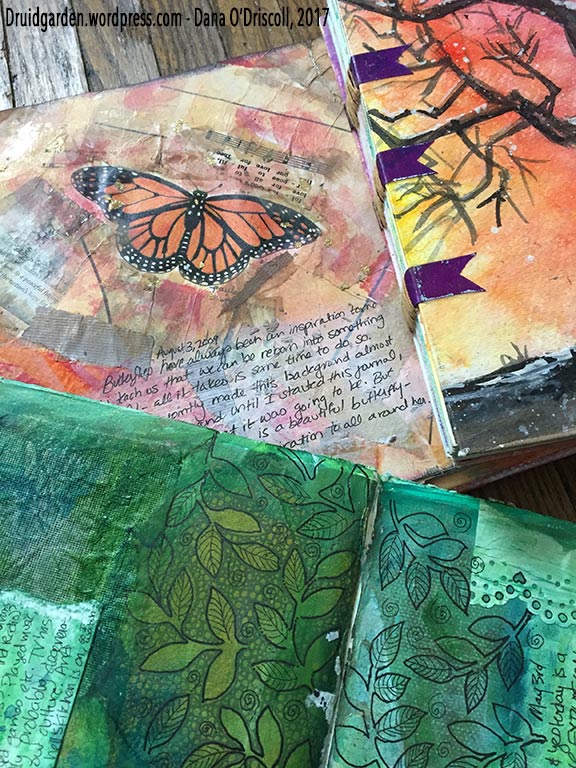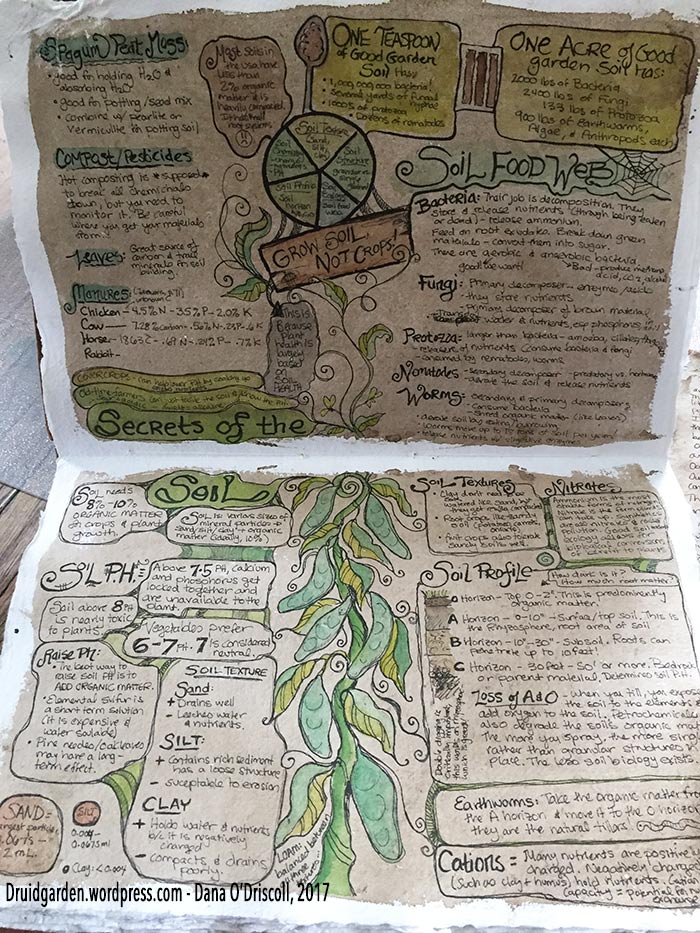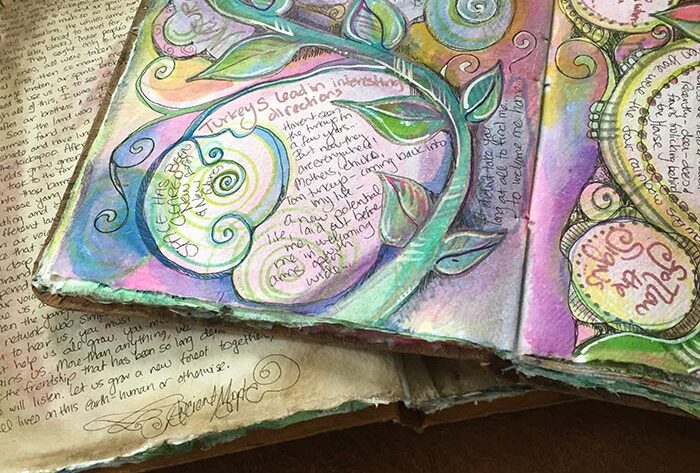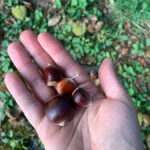
Recently, I took some time to go back through the many spiritual journals I have kept on my journey deeper into the mysteries of the druid tradition and my relationship with nature. These journals spanned over a decade. They included a bit of everything: garden interactions, meditations, nature observations, events in my life of deep spiritual significance, recipes, notes from gatherings and visits, stories, experiences with rituals, and much more. I am so grateful to have kept these journals and re-reading them allowed me to rediscover so many pieces about that journey. They allowed me to see not only my own growth over time, but reminded me of important events and encouraged me further on my path.
Journaling and writing down one’s journey doesn’t come easy for many, and I, too, have to work at it! Further, in working with those new to the druid path through my work as an Archdruid with the AODA, I’ve come to realize that many folks don’t know how to keep a spiritual journal nor what it can be used for or why they should do it. In my professional work as a writing professor, I know how difficult it is for some people to write anything because they lack the tools, motivation, or inspiration to do so. So, given this, I thought I’d take the time today to write about spiritual journals, why we keep them, and tips and strategies for keeping them (and keeping them well).
Why keep a spiritual journal?
When you are engaging in a spiritual practice of any kind, it is really helpful to document that practice. So let’s start by exploring the reasons why you would want to keep a spiritual journal.
The difference between sacred spaces and mundane spaces. One of the aspects of spiritual practices is that we are in a different head space for the duration of those practices than we are in the regular world. This is true not only of meditation and rituals but also of visits to natural places. We may gain deep insights or have moments of clarity and awakening and retaining those insights are critical for our development. If we don’t write them down, we are very apt to lose them.
I have found that in order to “not lose anything,” I have to write down my experiences in ritual or meditation immediately after they happen (often, I will write in my journal before I even close a sacred grove in ritual or before I leave the forest). This allows me to write about these experiences while they are fresh and in the forefront of my head. If I put off writing down my experiences, the longer that time goes by, the less I will remember and remember accurately–especially because visits to wild places and rituals alter our consciousness.
Inaccuracy of memory. Our memories are imperfect instruments and we can forget many things. If we write our experiences and understandings down (or use one of the other methods I share here), we offer our future selves a record of those experiences, which is a powerful spiritual tool. Trying to keep everything in our heads is a sure way to lose some of the critically important details or insights we gain as part of our spiritual practices.

To illustrate this, I’ll share a story here. I was out foraging for the day by myself, and I ended up in a really brushy area that required me to slog my way through about a two-acre bramble and brush patch. During this experience, I was in a deep meditative space. I had a critical number of keen insights about nature–all in a row (it must have been the stars aligning). The problem is, I had too many at once! (One of those keen insights about nature became my earlier discussion of weedtending, weedwalking, and weedcrafting while a second became my discussion of first-aid responder plants). I had recently lost my small journal I usually carried in my crane bag (to a river–it carried it away!), so I didn’t have anything to write down my insights on that particular day. And so, lacking any other means, I tried to commit as many as I could to memory. When I finally got back later that evening, all had escaped except the insights on the two posts I included above. Try and meditate as I might, I could not find the other insights anywhere in my brain–they were left in the bramble patch!
Keeping a Record. Documenting your practices and experiences through journals offers your future self a record about what you are feeling, experiencing, and the things you are engaging with at that particular point in time. This is a wonderful tool for tracking and understanding your own spiritual development. I love going back and reading my old journals and seeing just how far I have come! It’s also helpful to look at the journals and get a sense of what I was struggling with then, what I’m still struggling with, and what new things have come up.
Focusing, Expanding, and Reflection on Your Thoughts. Journaling is not just a process of writing down exactly what happened or what the insights were, but it’s also a powerful tool and opportunity to ponder or sit with those experiences further. And so, we gain a double benefit from this work. Reflecting on experiences that just happened allows you another way, which I see as another form of meditation, into those experiences. First, I have found often that after I finish a physical journey, spiritual journey, meditation, ritual, or whatever, writing down what has happened and my thoughts and insights about what has happened allows me to further shape and expand those thoughts (and actually, this is why I got into blogging!) Part of it is that you are not just getting the initial insight, but taking the time to think about it deeper and focus on it through the journaling experience. This helps the insights and experiences come into sharper focus. Second, reflection also allows us to slow down and think about what we experienced, synth sizing our experiences and our own understandings. We can pick things apart, turn them around, wonder about them, and really gain the ability to see them from multiple angles there in our journal. It might be that this kind of work needs to happen over a longer period of time than one entry, and that is perfectly acceptable as well. I’ll also mention here that research in writing studies strongly supports both of the above–we learn through writing and we gain much from reflection!
Content of the Journals: What to Write
The question of what should go into a journal is obviously a very personal one. Here are some possibilities for you to consider:
Documenting regular practices. In many of the esoteric traditions, keeping a “magical journal” is a required practice. It’s very helpful to document regular practices and their effects, especially over time. For example, each day I do the AODA’s Sphere of Protection ritual. In the years I was really learning it, I wrote down daily what happened. Now that my practice has stabilized, I no longer find it necessary to write down each day’s sphere unless something out of the ordinary happens during the sphere; but I still find myself writing about it regularly. I do write about my regular meditations, and that’s part of my habitual journal practice.

Salient, important things. I once spoke with a woman who told me she was spending more time writing in her journals than in her spiritual practices and was frustrated with the length of time it took to journal. I inquired further and discovered that she was writing down literally everything she was doing. While this certainly is an approach that you can take to spiritual journaling, I’m not sure its one I’d advocate. You’d spend more time, as she did, writing than actually engaging in your spiritual practices! Instead, what I advocate is writing down things of meaning, of salience, and of significance. In other words, I don’t write down every little thing (“I drove to the park”) but I do generally document what I did, what happened, and what I thought about it (“in my walk in the woods, this struck me because of…”).
Ideas, Plans, and Goals. I have found it useful to write about goals, ideas, and plans. If you write goals, check in on them regularly and see how you are progressing with them (a simple goal might be to develop a regular daily protective practice, or to spend more time in nature, or to observe the full and new moons in some way).
Nature observations. I have found it particularly helpful to document my observations and interactions with nature, given that I’m on a path of nature-based spirituality. For this reason, I almost always take a journal when I’m going out and about (even a small one I can carry with me, although I have a propensity for small journals getting eaten by bodies of water!)

Reflections over time. At the end of the journal, when I have only 10-20 or so pages left, I find it really useful to go back through the journal and record any patterns in my thinking, any changes, anything that sticks out of significance to me. It may take me a year or more to fill a journal, but is a very good practice and then helps me “launch” the next journal with a vision and goals in mind.
Photos, drawings, plant matter, and memorabilia. You don’t have to be limited to words alone–consider adding drawings, photos, plant matter, and other memorabilia.
The Look and Feel of Your Journal
Especially when you are starting out, the finding or making the right journal is really important. There’s something about opening up a fine journal, one that you are attracted to, and writing in it. It’s nice to see it sitting on our shelf, nice to hold and cherish. Your journal might be something you make or something you buy. (I can write a post on bookbinding and spiritual journal making if there is interest. Let me know!) You may also find that you may develop certain preferences (thickness of paper, lined or unlined, etc).
I think that there is something special about keeping a physical journal and I would strongly recommend you keep your journal physically. For one, if you are taking it into nature and into sacred spaces with you, the last thing you want is an electronic device in those spaces. The screens have a way of pulling you away and into them rather into the space. If the purpose of the journal is to record words, I would suggest using old-fashioned methods.
On the outside: If you are going to go with a purchased journal, You want a journal that lays flat, that is enjoyable to write in, and that is well constructed. One place to look is on Etsy and similar places and seeing if you can purchase a nice journal that was handmade with care and love. You’ll support an artist and also have a wonderful journal. Some journal makers (especially those working in leather) can make a journal cover that you can then replace the insides. This means that you could buy one journal + cover, and then when you are done, put the cover on a new journal and keep going, placing the old journal on your shelf. This is a nice option and represents a limited investment.
On the Inside: One of my very early spiritual journals was a simple affair, but homemade. I began by purchasing some hot press, low quality watercolor paper and folding them in half, making signatures. I bound the journal using a Coptic stitch technique with two boards. Then, in each of the pages, I did a simple watercolor wash. The watercolor pages dried and then, when I opened the journal, I had a variety of colorful surfaces on which to write.

You can do the same thing with cheap watercolors and any journal designed for multiple media or mixed media (these are readily available in arts and craft stores). These kinds of journals will be thicker and contain less pages, but will be sturdy and wonderful for colorful washes and bold printing.
Mixed media is another option. Mixed media refers to any two media that are not traditionally put together (so photographs and drawing), and this is a wonderful way of expressing more than just words. For example, perhaps you want to sketch, find an image, imprint a leaf, take a photo, and so on. Any of these can be readily incorporated into your journal. Sometimes, a picture helps capture the event or experience in ways that words cannot.
Keeping Different Journals
One thing that I have found works well for me as a more avid journaler is to keep different journals for different activities. For example, I have a journal that I use to record important dreams. That’s a separate journal from my everyday/meditation journal, and also separate from my nature journal. At other points in my life, I have found too many journals burdensome and only kept one that held everything within it. Here are some of the different kinds of journals you might keep:
- Meditation journal. For regular meditation practices (especially if you are using discursive meditation and/or spirit journeying as meditation).
- Nature journal. For experiences in observing outdoors (taken when you go outdoors, do nature observations, hike, etc). This journal can be small (a small Moleskine (SP)) journal works well for this purpose. You might want to keep it in a small plastic bag to protect it from the elements.
- Gardening journal. Keep track of your gardening adventures!
- Seasonal celebration journal. A journal that documents your seasonal celebrations and merriment.
- Work with spirits journal. A journal that documents inner journeys and connections to the spirit realm.
Or you might keep just one journal and use it for everything! There is no right or wrong way to journal.

Getting in the Habit of Journaling
One of the most tricky things for people starting out is to get in the habit of journaling. Here are a few tips and suggestions.
Perfectionism doesn’t matter. You do not need to have proper grammar, full sentences, correct punctuation, or even really legible handwriting in your journal. This journal is for you and you alone, so as long as you can read it, that is what matters.
Stream of consciousness writing can work. Many people write journals in long paragraphs or entries that are in the style of “stream of consciousness”; that is, they write what immediately comes up in their minds. You might see this similar to how some forms of meditation work—thinking about an idea and seeing where it goes. In the case of your journal, I think the most important thing is to get the information down that you want to get down, and it doesn’t have to be a literary masterpiece.
If writing doesn’t work, audio record (and transcribe). Some people find that when they sit down to write they have difficulty putting any words down on paper. They stare at blank page. If you fall into this category, one suggestion I have is to use a small recorder and record your thoughts in audio format (like you are talking to a friend or to yourself) and then, later, transcribe those words into your journal. This adds a step, but it might be good to help you get going.
Keeping a journal is about habituating practice. One of the other challenging things to do for new journal keepers is just to get in the habit of regular writing. Above, I suggested writing as soon as you are finished with a practice or experience that you want to document. I also would suggest that if you aren’t doing anything else, setting aside a time to journal once a week is a good way to start. Once you have gotten in the habit of journaling, it will become easier to do. Start taking your journal with you anywhere you go–on a trip, out into the woods, into your sacred space–and then work to use it!
Concluding Thoughts
I hope this post was helpful to those who are interested in starting a spiritual journal or in kicking their own journaling into a higher gear. After a period of years, I can say with certainty that this practice has really helped me deepen my own awareness, my focus, and helped me progress along my spiritual path.
As an aside, I will be taking a few weeks off from blogging while I do some travel and get our big garden in for the year! I’ll return in late May with additional posts on my permaculture for druids series, information on the bardic arts, and so much more! Blessings on this Beltaine!




I needed this reminder. I kept a journal for all of 2016 to reflect on events that year, but due to circumstances, did not start one for 2017 and really ought to. I still have a tiny bit of self-consciousness about personal details that I write down, in case someone finds it, or goes through my belongings after I’ve left this place, so I tend to keep those to an online journal where it’s much less likely someone I know will read it. Enjoy the blog vacation!
Kieron, I sometimes think about what might happen if someone could read my journals. And then I decided that I really don’t care, lol. So they are what they are 🙂
Reblogged this on Rattiesforeverworldpresscom and commented:
Wonderful 🙂 You make me want to do it
Try it out! It is very rewarding 🙂
What a lovely post! I love your pictures, as your journals are just so beautiful and inspiring! Your points toward journaling are so thorough and meaningful, especially the one about forgetting revelations in the bramble. This definitely inspired me to try and get back into journalling. Thank you!
You are most welcome. Thanks for the comment! 🙂
Hi Dana,
I keep a daily journal but your post has made me want to work in my painted Druid book. I love your happy paintings and want to do more of that work myself. Thank you for the inspiration. I hope you have a wonderful Beltane.
PS I have been reading Ruth Goodman’s, “How to be a Victoria.” The ladies back then collected elder flower blossoms and soaked them in water overnight and washed with the water and used the flowers as a scrubby. The flowers smell wonderful and contain glycerin and so are very good for your skin. I am making this a part of my Beltane tradition.
Yours under the red cedars,
Max Rogers
Hi Max! Elderflower at Beltane? Ours blooms here at the Summer Solstice, lol. Your season is way ahead of mine, by a full eight weeks! This year, the blossom is upon the thorn, amazingly enough. Sometimes it is two or three weeks past Beltane till the hawhtorns bloom. I shall have to try the elderflower scrub 🙂
Thank you. Much Appreciation and Blessings on this Beltaine! <3
Bright blessings to you as well!
Thanks so much for sharing insights into your journals! I usually keep mine with mostly text and a few sketches, but I never even considered using colour (or even watercolours, for that matter). I shall have to give a more colourful, creative approach a go!
Even a very simple watercolor wash on thicker pages (like a watercolor journal or bristol pages, etc) can produce a really nice result! Have fun! 🙂
[…] via On Keeping a Spiritual Journal — The Druid’s Garden […]
Hi, Dana–a beautiful post, thank you. I’d be very interested in a bookbinding post, if you feel the urge when you return from your break. Blessings!
Journal as spiritual exercise. Blogging as journaling. Very nice. Thank you. Indeed, it is the season to cultivate the garden of vegetables and the garden of the soul.
I use my phone to write things down, couldn’t do what you describe without having something to record my experiences. Absolutely right about insight coming in thick and fast and if not recorded it will be gone. Then, on my return I write it all in blog posts.
Reblogged this on Journeying Soul.
Thanks for the reblog 🙂
“I can write a post on bookbinding and spiritual journal making if there is interest. Let me know!” Yes please! I have kept many many journals over the years and this practice has been such a source of comfort, inspiration, clarity, and fulfillment. The logical next step for me is to learn how to make my own journals. I feel ready for this. So anything you can suggest as far as learning how to bookbind, etc., would be much appreciated. Thank you for this wonderfully inspiring post. I love your handwriting and your artwork! <3
Absolutely! I’ll start working on the post once I’m back from my blogging hiatus 🙂
Wonderful. Enjoy the space and the time to just BE. Enjoy this beautiful earth.
I also would love to see a post on bookbinding. I’m new to druidry and am also an artist and have just started keeping a journal (which I put together from a youtube tutorial) and would love to learn more about making journals. It makes the journal so much more personal
Ok, thanks! I’ll see what I can do 🙂
I enjoyed this so much! And all the photos. I would love to learn from you how to make my own journals, that hold together, beautiful, personal and sturdy!
Hey Dana! Thank you so much for writing this post. I know I came across it quite late, but let me ask: as an OBOD Druid I have also had the need to keep a journal, but I never really decided for or against keeping my Druid practice journal in the same volume as my regular, emotional, “dear diary” kind of journal… which means I have a number of scattered, half-started notebooks around. In general, having several books to maintain at the same overwhelms me, and I figure I have only one life, so one book should be fine, but then again mixing diaries with spiritual journals (and commonplace books!) seems to be rarely mentioned out there. What is your opinion on that?
Thanks in advance.
I think it depends on your perspective about how much of your life is considered “spiritual practice.” In the occult and ceremonial magic traditions, these things are certainly separate (a magical journal is kept, and it is separate and serious business). However, OBOD druidry is a lot different than that, so it depends on your philosophy of it and how you plan on using them. I personally would actually suggest you keep different journals. I have “life” journals for regular stuff that doesn’t necessarily tie to my spiritual practice, and I don’t want that in my spiritual journals. I review my spiritual journals each year at the equinox, and I wouldn’t necessarily want to read through all the “life” stuff as well. But that’s just me. For people who see druidry as a life path, it may make sense to combine everything (as everything I do is a druid).
[…] https://druidgarden.wordpress.com/2017/04/30/on-keeping-a-spiritual-journal/ […]
Thank you for the link!